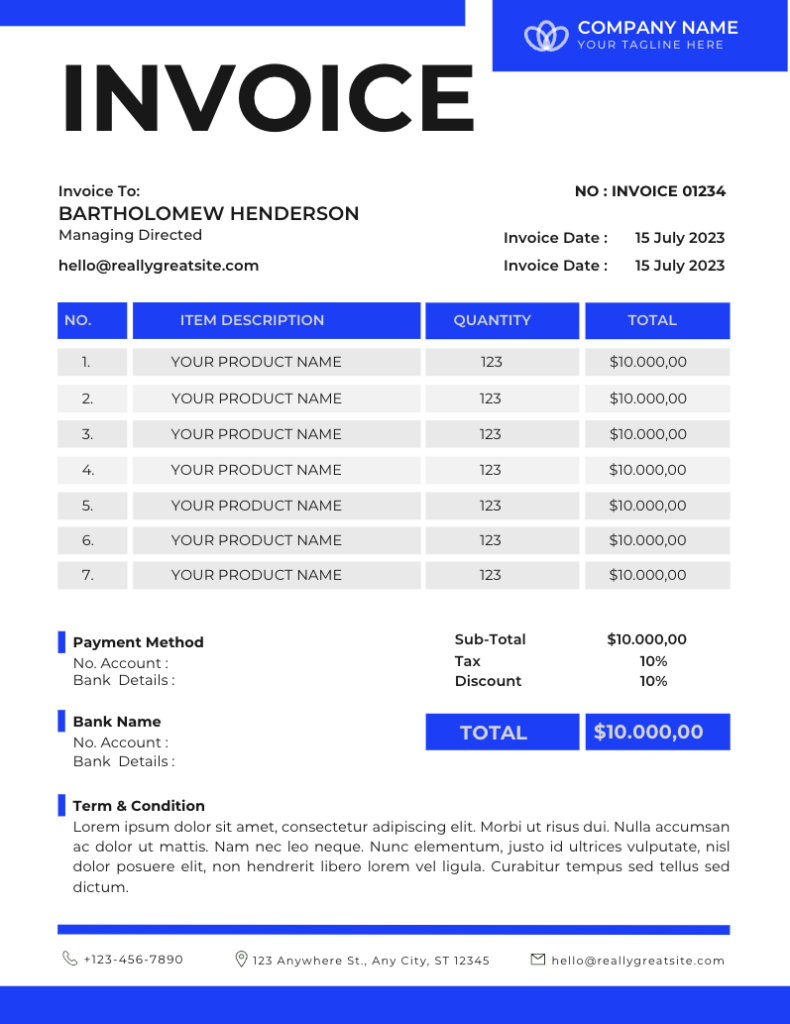Keeping your finances in check is crucial if you want a thriving business. But if you’re new to invoicing, it can be daunting to put together your very first one. Don’t worry, you’re not alone—many small businesses struggle with writing invoices.
We get it, and we’ve got you covered. In this article, we’ll show you how to write an invoice step by step, using examples and a template to make the process as easy as possible. But before we dive into the details, let’s talk about why invoicing is so important for your business.
First and foremost, invoicing makes you look professional. A well-crafted invoice demonstrates that you take your business seriously, and that you value your clients’ time and money. It also helps you build stronger relationships with those clients, as clear and timely invoicing fosters trust and confidence.
Invoicing also helps you stay organized and on top of your finances. With each invoice, you have a record of the work you’ve done and the payment you’re owed. This helps you track your financial progress, forecast cash flow, and prepare for tax season.
All in all, writing good invoices isn’t just a chore—it’s a crucial part of running a successful business. So let’s get started.
What Is an Invoice?
An invoice is essentially a document that records the details of the products or services that have been provided to a customer or client. It outlines the quantity, unit price, total cost, and any applicable taxes or fees. Most importantly, an invoice is used to collect payment from your customers or clients.
While it may seem like a small detail in the grand scheme of things, not writing invoices can have serious consequences. Firstly, you may not get paid for the work that you’ve done. Without an invoice in place, it’s easy for customers to forget about their obligations, or to dispute the amount owed without any clear documentation to back it up. This can lead to loss of income and financial instability for your business.
In addition to ensuring timely and accurate payments, invoicing is also important for keeping track of your finances. Without proper documentation, it can be difficult to understand your cash flow, profitability, and overall financial health. By regularly creating and storing invoices, you can easily track your income and expenses, and make informed decisions about the future of your business.

How to Write an Invoice in 9 Steps
To begin writing an invoice, you must consider a few things regarding your company and the clients you work with. Keep your business goals in mind and use this invoice as a chance to bring excellence to your company.
Step 1: Keep it Professional
When learning how to write an invoice, it is vital to keep the layout professional. This will ensure your clients build trust with your company, and you can remain confident they will make their payments on time. This can also be a space to showcase your company’s logo, giving your client something to remember you by.
Just don’t forget to add “invoice” to the top of the page to distinguish the type of document your client is receiving. This should be large enough that it is one of the first things you notice on the page.
Step 2: Keep it On-Brand
Make sure your invoice includes key elements of your branding, such as logos, colors, and fonts. This helps to establish your company’s identity and makes your invoice easily recognizable to your clients.
Step 3: Keep Design in Mind
While it’s important to include all the necessary information, the design of your invoice is also crucial. Keep your design simple and clean, with clear headings and sections. Consider adding a table or grid to organize your information, and keep your font size and style consistent throughout.
Step 4: Have All of Your Information in Order
When developing your invoice, it is crucial to have all the information so that you may need to complete the invoice process. This will help you stay organized as you cater each invoice to your clients.
You will need contact information, such as phone numbers, e-mails, or fax numbers for your company and your client as well. You must gather these details and have them filed in preparation to fill out the invoice. Be sure all of the contact information you include is up to date as well.
Add in the invoice date, the date the payment will be due, and the invoice number curated specifically for this client. This invoice number is the key to the structure when keeping tabs on your team’s clients and the services you have provided.
You will need a section for your client’s information after. Then, you will add your company’s information below.
Step 5: Display Your Services Clearly
This list is the core of your invoice and ultimately the reason you are creating an invoice to send out, to begin with. You want to list the services you supplied with a simple but descriptive name so it’s clear what the client is invoiced for. This allows your client to visualize the correspondence between the service you provided and the payment that is due in return.
Once you have listed the services and their rate, you can fill out the subtotal of everything so there is a breakdown of pricing and an overall total to look at.
6: Include Details About Your Products/Services
Make sure you include detailed information about the products or services you’re billing for. This should include the quantity, description, and price for each item, as well as any applicable taxes or discounts. Be as specific as possible, so your clients know exactly what they’re paying for.
Step 7: Payment Details and Company Policies
Ensure your company has a set of payment terms to go by, describing how you handle payments, late fees, and the types of payments your business will accept. You must illustrate these terms for your clients and make sure they understand the policies your company stands by. This policy may pertain to late payments, fees, or handling scenarios where no payment is made at all. By being upfront about these policies, you are more likely to get paid faster.
This helps to keep clients up to date on your policies so in return they remain compliant in paying by the due date.
Pro tip: Make paying you convenient by offering the payment options your customers prefer, like text-to-pay.
Step 8: Add Personalized Notes
While it might seem optional, adding personalized notes can go a long way in building strong relationships with your clients. Consider adding a brief thank you message or mentioning something specific regarding the work you’ve done for them. This personal touch will make your clients feel valued and appreciated.
Step 9: Add Any Extras
This end of your invoice is a freebee; add in any discounts, loyalty programs, or personal comments you may want to add in to conclude your invoice and leave your client on a positive note. This will benefit the client from working with you and help maintain a relationship with them, hoping they want to work with your company again in the future.
Once you have gone through these steps, it is time to piece everything together for a specific client to send an invoice. You have been collecting information, preparing payment terms and finally developed a trusted process to write a perfect invoice with ease each time. Remember that not all invoicing tools are the same. For example, the best auto repair invoicing software probably won’t work for a handyman contractor, so make sure to conduct some research to find the right invoicing solution.
You can now tackle your client’s invoices, get them written out, organized, and sent out on a schedule. This will promote on-time payments and aid in the overall financial success of your company.

What to Include in an Invoice
You must incorporate many details to keep the document systematic and efficient when creating an invoice. You want to be sure the invoice is direct and easy to read; this way your clients have a clear message regarding the payment they owe and when it is due.
You also want to include your payment terms and company policies so your clients have an understanding of your legitimacy. This template will ensure better communication with your clients and continued success for your marketing team.
Here are the significant components recommended in your invoice:
1. Invoice
At the top of your document, you want to include the word “invoice” in big, bold letters. This will enable your clients to recognize what the document is immediately.
2. Date and Invoice Number
Below “invoice,” you must add a date (when the invoice was created) and a unique invoice number. This number will be linked to the specific bill you are referencing, making it easier to organize and recall various clients; this is also helpful for record-keeping.
3. Client’s Name and Contact Information
This section will have the client’s name or company name, address, phone number, and any other valid contact information.
4. Company Name and Contact Information
This section is for your company’s name and different ways to contact you. This includes a phone number, fax number, e-mail, and any other information you feel is relevant here.
5. List of Goods/Services and Rate
After you have added all the contact information, you will create a simple chart listing the services you provided to the client and the corresponding rate of each one. This clarifies each individual service and how the overall payments break down into the subtotal. This should be easy to read and understand.
6. Subtotal
Once you have listed the services and rates, you must add up the total cost and list it as the subtotal. You will also include a due date, guaranteeing your client is fully aware of the deadline regarding when their payment should be made so you can get paid on time.
7. Payment Terms/Payments You Accept
This acts as a place for you to explain your company’s policies and payment terms, which is critical to ensure timely payments every time. Every business must have a set of payment terms that they establish with clients and reiterate in the invoice if it was overlooked in the contract. You should also include a blurb about what forms of payments you accept. It is always best to have a wide variety of payment options, so you can be flexible for your clients and get paid faster.
Once you have put the pieces of your invoice together, it is always a good idea to do a quality assurance check. Look for any spelling errors or typos that need to be fixed before the document is sent out. Ensure you have a stable process to follow and that your standards are represented through the invoice you develop. This will make certain that you are conveying your message correctly.
You can also add a section at the end of the invoice to thank your client for working with you, adding to the document’s personalization and professionalism.
How to Write an Invoice: Example Template
Getting paid on time for the work you do is crucial for the success of your business, and having a well-written, well-designed invoice can make all the difference.
That being said, actually putting together your invoice is the toughest part, especially if you’re not very design-savvy. Here’s an example of a template you can use:

By following the guidelines in this article and using the example image above, you can provide a better sense of organization and structure to your invoices. This will help you to exceed as a company, finding value in every transaction you make to maintain a steady cash flow. You can keep the entire financial aspect of your business successful by utilizing an invoice, now and in the future.




